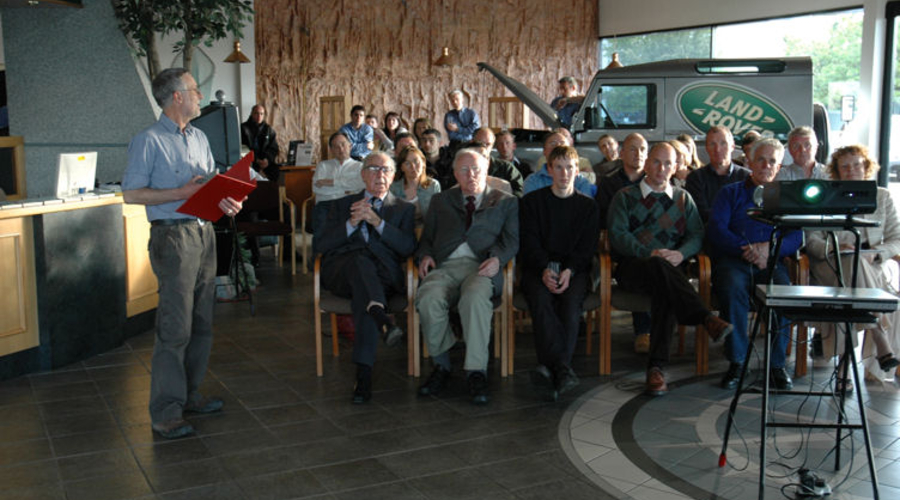They might be famous to four-wheel-drive geeks… but an expedition team 50 years ago was also an inspiring example of user-generated content. Olwyn Hocking reports from the RTS May event at Carlisle.
Back in 1955, the challenge of driving from London to Singapore was frightening enough. Dense jungle, decaying bridges, deserted wartime routes…the teams from Oxford & Cambridge driving two Series 1 Land-Rovers seemed unlikely to complete the 18,000 miles and set a new world record.
And then an additional challenge emerged. A camera was provided — they would take shots along the way, and send films back by courier and post. Only when it was developed back in the UK would they know whether they had succeeded in recording images — and if they'd failed, they'd be many miles on by the time their feedback arrived, by letter.
They succeeded — to a breathtaking degree. The packed audience at the Lloyd Land Rover showroom in Carlisle was shown by 'First Overland' DVD producer Graeme Aldous pictures of a quality that is only now being appreciated.
Graeme Aldous explores 'Forgotten Roads' with the Carlisle audience
The original screening by the BBC was in black-and-white. It was then never seen again. Now we can see it in colour, and the 16 millimetre film captured detail and colour with remarkable immediacy. Though a novice with a movie camera, the operator Antony Barrington-Brown went to great trouble in difficult conditions to shoot sequences and cutaways.
He had several incentives to succeed. The BBC commissioner was a youngster called David Attenborough — head of the newly-formed Travel and Exploration Unit. They had big ideas but little budget and were keen to acquire material from explorers. And the film then brought in sponsors, making the historic attempt viable.
But he had to cope with technical complications unimaginable today. The wind-up camera could only store enough power for a 30-second shot. The operator had to select from three lenses by guessing the distance, and framing was extremely difficult as there was no viewfinder to show what the lens was seeing.
The audience was shown marvellous sequences which even fifty years on convey the dangers facing the expedition. Neglected bridges shed chunks of wood when tested by a kick. One bridge sign said "ten pony loads only" — a weight far less than a single Land-Rover. Rivers were forded one vehicle at a time so that if one got stuck, one would remain. "It was all a pretty hairy business," said Graeme: "this is a classic story of exploring and Land-Rover history."
The audience saw a fraught moment — weeks into the expedition — which could have ended the whole adventure. A fallen tree trunk blocked a road deep in jungle. The Land-Rover could JUST squeeze under it. A foot lower and they would have had to turn round.
The DVD production was the realisation of a boyhood dream for Graeme. He actually saw the Cambridge Land-Rover in 1955, setting off towards Dover with the proud inscription 'Oxford and Cambridge Far Eastern Expedition'. He read the bestselling book about the journey and when it was re-issued, 50 years on, became interested in tracking down the original film.
To re-issue it, he had to grapple with the lack of sound. Wind-up camera recordings were mute, so he decided with camera operators Mike Hairsine and Ted Parker to record interviews of the expedition members viewing the original and commenting on what they saw. His sense of production quality meant he found it difficult to accept the very visible 'sticky tape' film edits and eventually trimmed every single edit point! — the film was more than six minutes shorter as a result! You might like to calculate how many that was (he removed two frames before and three frames after) — answer at the end..
The resulting DVD has been selling well across the world. To find out more, visit www.teeafit.co.uk/firstoverland
Although this forgotten film is back in the public eye, mystery remains over whether the Land-Rovers themselves still exist. One went to Ascension Island and was probably cannibalised for parts. There's no trace of the other. With such enthusiasm to recapture this part of motoring heritage (one member of the audience travelled more than two hours from Kirkcaldy to attend the presentation), perhaps a future project will begin to start the detective work to find the First Overland Land-Rovers.
OLWYN HOCKING
(Answer — 2003 edits)

